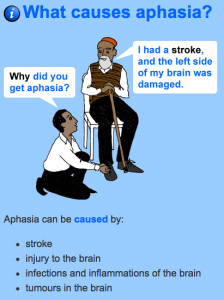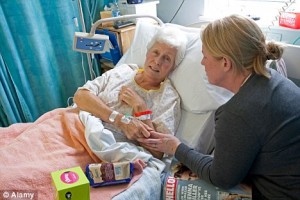Speech Therapy for Adults with Aphasia
On January 8, 2011, Americans were stunned to hear of the assassination attempt on Senator Gabrielle Giffords. Giffords was shot in the head, but miraculously survived. As she recovered, Giffords struggled to learn how to speak. She was diagnosed with aphasia, which is an acquired communication disorder. Aphasia does not impair a person’s intelligence, but it does impede the ability to process language, to speak, and to understand another person’s speech.
Causes
Typically, aphasia is acquired due to damage incurred on the left side of the brain. Most adults acquire aphasia because of a stroke, which damages the brain. Because this is the most common cause of aphasia, older adults are more likely to be diagnosed with this disorder. Sometimes, patients may acquire it due to a brain tumor or a head injury, as in the case of Senator Giffords.
Symptoms
Cases of aphasia can range from mild to severe and not all patients will struggle with the same dilemmas. For example, some patients may have trouble following conversations, while others will have great difficulty speaking. Some people also have trouble reading and writing.
Recovering from aphasia is a slow process and most patients are never able to completely restore their communication skills. Complete restoration of communication becomes less likely if the patient continues to display symptoms of aphasia longer than two to three months following the damage to the brain. As is usually the case, the best results are typically seen when treatment begins early.
Treatment
To begin the treatment for aphasia, the speech-language pathologist (SLP) will likely give the patient simple tasks. The patient may be asked to name familiar objects, like a bed, a lamp, and a book. While the patient builds his communication skills, he will also likely be shown alternative means of communication to reduce frustration. Gestures and drawings are commonly used. For example, Gabrielle Giffords learned to point to her stomach when she was hungry, before she progressed to saying, “I’m hungry.”*
Many patients with aphasia benefit from working in groups with other patients that suffer from this disorder. It is also helpful when the patient’s family members and friends work on communication skills between speech therapy sessions. To help your loved one, turn off the TV and reduce any other background noises as much as possible. Speak slowly and use short, simple sentences. Allow your loved one plenty of time to finish his sentence and avoid correcting any errors. Be prepared to help him out with paper and a pen in case he needs to draw something. If he has trouble understanding what you’re saying, draw a picture of it.
Begin the conversation with familiar subjects, such as your loved one’s favorite sport. You could also discuss what he had for lunch that day. Avoid jumping from topic to topic quickly. Avoid open-ended questions, as well. For example, ask him if he would like a turkey sandwich or a tuna sandwich, rather than asking him what he would like for lunch. Pay attention to nonverbal signals. Patients with aphasia who have trouble getting their words out may gesture or use their eyes to communicate. For example, if you notice that your loved one frequently looks at a water glass, he may be telling you that he is thirsty.
Support Groups
The development of aphasia is a life-changing event for both the patient and his family members. Do not hesitate to reach out to support groups for help. Your loved one’s SLP may be able to provide you with information on local support groups. Otherwise, check with the National Aphasia Association or the Aphasia Hope Foundation.





